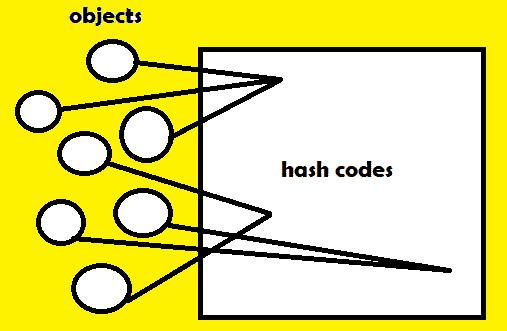# Java `hashCode()`方法示例
> 原文: [https://javatutorial.net/java-hashcode-method-example](https://javatutorial.net/java-hashcode-method-example)
Java `java.lang.Object`中的超类提供了两种比较对象的重要方法:`equals()`和`hashcode()`。当面对实现类之间的交互时,这些方法被广泛使用。 在本教程中,我们仅看一下`hashCode()`。

## 方法定义与实现
`hashCode()`:默认情况下,此方法返回每次都是唯一的随机整数。 例如,如果第二次执行应用程序,则该值将不同。`hashCode`值主要用于哈希格式的集合中,例如 [HashSet](https://javatutorial.net/java-hashset-example),[`HashMap`](https://javatutorial.net/java-hashmap-example)等。请注意,在覆盖`equals()`方法的每个类中都必须覆盖此方法。

`hashCode`的简单说明
## `hashCode()`可以使用的集合列表
* [`HashSet`](https://docs.oracle.com/javase/7/docs/api/java/util/HashSet.html)
* [`TreeSet`](https://docs.oracle.com/javase/7/docs/api/java/util/TreeSet.html)
* [`LinkedHashSet`](https://docs.oracle.com/javase/7/docs/api/java/util/LinkedHashSet.html)
* [`CopyOnWriteArraySet`](https://docs.oracle.com/javase/8/docs/api/java/util/concurrent/CopyOnWriteArraySet.html)
## 什么时候应该使用`hashCode()`方法
如果我们想执行`equals()`方法,则需要确保这些对象具有相同的**唯一哈希码 ID**。当哈希码 ID 不同时,我们永远不要执行`equals()`。
**注意**:当`hashCode()`比较返回**假**时,`equals()`方法还必须返回**假**。 如果哈希码**不同**,则对象**不等**。
## `hashCode()`和`equals()`的实际示例
```java
import java.lang.*;
public class hashCodeExample {
public static void main(String[] args){
Car BMW = new Car(1, "BMW"); // 1 --> ID, 2 --> the name of the car brand
Car mercedes = new Car(2, "Mercedes"); // 1 --> ID, 2 --> the name of the car brand
boolean isHashcodeEqual = BMW.hashCode() == mercedes.hashCode();
if (isHashcodeEqual) {
System.out.println("Equal");
} else {
System.out.println("No need to compare with equals() method as it is clear " +
"that the id of these objects is not equal.");
}
}
static class Car {
int id;
String brand;
public Car (int id, String brand) {
this.id = id;
this.brand = brand;
}
@Override
public boolean equals(Object obj) {
if(this == obj) {
return true;
}
else if(obj == null || getClass() != obj.getClass()) {
return false;
}
Car car = (Car) obj;
return id == car.id && brand.equals(car.brand);
}
@Override
public int hashCode() {
return id;
}
}
}
```
### 上面代码的简要分解
在前几行中,我们将创建两个`Car`对象,并传递一个`id`和一个品牌名称。
```java
Car BMW = new Car(1, "BMW"); // 1 --> ID, 2 --> the name of the car brand
Car mercedes = new Car(2, "Mercedes"); // 1 --> ID, 2 --> the name of the car brand
```
然后,我们将一个布尔值存储在名为`isHashCodeEqual`的变量中,该变量根据两个对象的 ID 是否相等而为`true`或`false`。
```java
boolean isHashcodeEqual = BMW.hashCode() == mercedes.hashCode();
```
在那之后,我们有一个条件可以检查`isHashCodeEqual`是`true`还是`false`。 如果为`true`,则表示两个对象的 ID 相等。 如果不是,则意味着相反。 如果它们相等,我们只需打印“相等”。 如果不是,我们将打印一条有用的消息,该消息基本上会说,如果它们不相等,则无需使用相等进行检查,因为这两个对象不共享相同的 ID。
```java
if (isHashcodeEqual) {
System.out.println("Equal");
} else {
System.out.println("No need to compare with equals() method as it is clear " +
"that the id of these objects is not equal.");
}
```
接下来是我们的静态类`Car`。
```java
static class Car {
int id;
String brand;
public Car (int id, String brand) {
this.id = id;
this.brand = brand;
}
@Override
public boolean equals(Object obj) {
if(this == obj) {
return true;
}
else if(obj == null || getClass() != obj.getClass()) {
return false;
}
Car audi = (Car) obj;
return id == audi.id && brand.equals(audi.brand);
}
@Override
public int hashCode() {
return id;
}
}
```
## `hashCode()`的常见错误
* 在`hashCode()`方法中返回一个常量值,而不是为每个对象返回唯一的值。
* 使用`HashMap`之类的哈希集合时,不覆盖`equals()`和`hashCode()`。
* 忘记使用`equals()`方法或其他方法覆盖`hashCode()`。
## 有关`hashCode()`的重要注意事项
1. 使用有效的算法,以便生成唯一的哈希码
2. 覆盖`equals()`方法时,请始终确保也覆盖了`hashCode()`方法。
3. 如果比较两个对象的哈希码的结果为`false`,则`equals()`方法也应为`false`。 (请参见上面的代码示例)
4. 如果在起诉哈希集合时没有覆盖`equals()`和`hashCode()`,则该集合将具有重复项。
- JavaTutorialNetwork 中文系列教程
- Java 基础
- Java 概述
- 在 Ubuntu 上安装 Java 8 JDK
- Java Eclipse 教程
- Eclipse 快捷方式
- 简单的 Java 示例
- Java 基本类型
- Java 循环
- Java 数组
- Java 读取文件示例
- Java 对象和类教程
- 什么是面向对象编程(OOP)
- Java 封装示例
- Java 接口示例
- Java 继承示例
- Java 抽象示例
- Java 多态示例
- Java 中的方法重载与方法覆盖
- Java 控制流语句
- Java 核心
- 如何在 Windows,Linux 和 Mac 上安装 Maven
- 如何使用 Maven 配置文件
- 如何将自定义库包含到 Maven 本地存储库中
- 如何使用 JUnit 进行单元测试
- 如何使用 Maven 运行 JUnit 测试
- 如何在 Java 中使用 Maven 创建子模块
- 如何使用 Maven 创建 Java JAR 文件
- 如何使用 Maven 创建 Java WAR 文件
- JVM 解释
- Java 内存模型解释示例
- 捕获 Java 堆转储的前 3 种方法
- Java 垃圾收集
- Java 互斥量示例
- Java 信号量示例
- Java 并行流示例
- Java 线程同步
- Java 线程池示例
- Java ThreadLocal示例
- Java 中的活锁和死锁
- Java Future示例
- Java equals()方法示例
- Java Lambda 表达式教程
- Java Optional示例
- Java 11 HTTP 客户端示例
- Java 类加载器介绍
- Java 枚举示例
- Java hashCode()方法示例
- 如何测试独立的 Java 应用程序
- SWING JFrame基础知识,如何创建JFrame
- Java SWING JFrame布局示例
- 在JFrame上显示文本和图形
- 与JFrame交互 – 按钮,监听器和文本区域
- 如何使用 Maven 创建 Java JAR 文件
- Java Collection新手指南
- 选择合适的 Java 集合
- Java ArrayList示例
- Java LinkedList示例
- Java HashSet示例
- Java TreeSet示例
- Java LinkedHashSet示例
- Java EnumSet示例
- Java ConcurrentHashSet示例
- Java HashMap示例
- Java LinkedHashMap示例
- Java TreeMap示例
- Java EnumMap示例
- Java WeakHashMap示例
- Java IdentityHashMap示例
- Java SortedMap示例
- Java ConcurrentMap示例
- Java Hashtable示例
- Java 中ArrayList和LinkedList之间的区别
- Java HashMap迭代示例
- Java HashMap内联初始化
- Java 中HashMap和TreeMap之间的区别
- Java 图示例
- Java 深度优先搜索示例
- Java 广度优先搜索示例
- 不同的算法时间复杂度
- Java 序列化示例
- Java 反射示例
- Java 中的弱引用
- Java 8 日期时间 API
- Java 基本正则表达式
- 使用 Java 检索可用磁盘空间
- Java 生成 MD5 哈希和
- Java 增加内存
- Java 属性文件示例
- 如何在 Eclipse 上安装 Java 9 Beta
- Java 9 JShell 示例
- Java 9 不可变列表示例
- Java 9 不可变集示例
- Java 9 不可变映射示例
- Java 单例设计模式示例
- Java 代理设计模式示例
- Java 观察者设计模式示例
- Java 工厂设计模式
- Java 构建器设计模式
- Java 比较器示例
- Java 发送电子邮件示例
- Java volatile示例
- Java Docker 和 Docker 容器简介
- 安装和配置 MySQL 数据库和服务器以供 Spring 使用
- 如何在 Java 中使用 MySQL 连接器
- 如何使用 Eclipse 调试 Java
- Java EE
- 如何在 Windows 10 中设置JAVA_HOME
- JavaBeans 及其组件简介
- 如何安装和配置 Tomcat 8
- 如何在 Tomcat 中部署和取消部署应用程序
- 从 Eclipse 运行 Tomcat
- Java Servlet 示例
- Java Servlet POST 示例
- Servlet 请求信息示例
- Servlet 注解示例
- 使用初始化参数配置 Java Web 应用程序
- Java Servlet 文件上传
- Java JSP 示例
- Glassfish 启用安全管理
- 如何使用 MySQL 配置 Glassfish 4
- Java 文件上传 REST 服务
- Glassfish 和 Jetty 的 Java WebSockets 教程
- 基于 Glassfish 表单的身份验证示例
- 如何使用 Java EE 和 Angular 构建单页应用程序
- Spring
- 在 Eclipse 中安装 Spring STS
- 使用 STS 创建简单的 Spring Web App
- Spring Web Framework 简介
- Java Docker 和 Docker 容器简介
- 在 Spring 中实现控制器
- Spring 中的PathVariable注解
- Spring 中的RequestBody注解
- Spring 中的RequestParam注解
- Spring 拦截器
- Spring IOC
- Java Spring IoC 容器示例
- Spring 中的DispatcherServlet
- Spring 示例中的依赖注入
- 实现 Spring MVC 控制器
- Spring ORM 简介
- 什么是 DAO 以及如何使用它
- 如何对 DAO 组件进行单元测试
- 如何对控制器和服务执行单元测试
- 安装和配置 MySQL 数据库和服务器以供 Spring 使用
- 如何在 Spring 中处理登录身份验证
- Spring Security 简介及其设置
- 如何使用 Spring 创建 RESTful Web 服务
- Spring CSRF 保护
- Spring 中基于 OAuth2 的身份验证和授权
- Spring Boot 简介
- Spring MVC 框架介绍
- Spring JDBC 简介
- 如何 docker 化 Spring 应用程序
- Spring 的@Autowired注解
- Spring AOP 中的核心概念和建议类型
- Sping Bean 简介
- 如何在 Java 中使用 MySQL 连接器
- 安卓
- 安装和配置 Android Studio
- 将 Android 设备连接到 Android Studio
- Android 简介,活动,意图,服务,布局
- 创建一个简单的 Android 应用
- 运行和调试 Android 应用程序
- 在虚拟设备上运行 Android 应用程序
- Android 活动示例
- Android 意图示例
- Android 服务示例
- Android 线性布局示例
- Android 相对布局示例
- Android Web 视图示例
- Android 列表视图示例
- Android 网格视图示例
- 带有ListAdapter的 Android ListView示例
- Android SQLite 数据库介绍
- Android SQLite 数据库示例
- Android 动画教程
- Android 中的通知
- Android 中的事件处理
- 如何在 Android 中发送带有附件的电子邮件
- 杂项
- 选择您的 JAVA IDE:Eclipse,NetBeans 和 IntelliJ IDEA
- Java S3 示例
- 如何在 Ubuntu 上为多个站点配置 Apache
- 如何在 Liferay DXP 中替代现成的(OOTB)模块
- 简单的 Git 教程
- 使用 Java 捕获网络数据包
- Selenium Java 教程
- 使用特定工作区运行 Eclipse
- 在 Eclipse 中安装 SVN
- 如何运行 NodeJS 服务器
- SQL 内连接示例
- SQL 左连接示例
- SQL 右连接示例
- SQL 外连接示例
- 树莓派
- Raspberry Pi 3 规格
- 将 Raspbian 安装到 SD 卡
- Raspberry Pi 首次启动
- 远程连接到 Raspberry Pi
- 建立 Raspberry Pi 远程桌面连接
- Raspberry Pi Java 教程
- 使用 PWM 的 Raspberry Pi LED 亮度调节
- Raspberry Pi 控制电机速度
- Raspberry Pi 用 Java 控制直流电机的速度和方向
